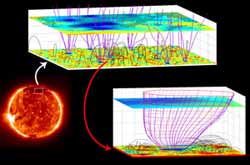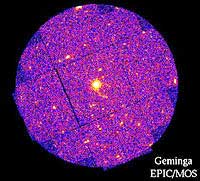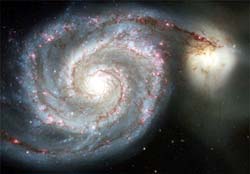This area deals with the fundamental laws and building blocks of nature and how they interact, the properties and the behavior of matter, and research into space and time and their structures.
innovations-report provides in-depth reports and articles on subjects such as astrophysics, laser technologies, nuclear, quantum, particle and solid-state physics, nanotechnologies, planetary research and findings (Mars, Venus) and developments related to the Hubble Telescope.

Scientists at Ohio State University have taken a step toward the development of powerful new computers — by making tiny holes that contain nothing at all.
The holes — dark spots in an egg carton-shaped surface of laser light — could one day cradle atoms for quantum computing. Worldwide, scientists are racing to develop computers that exploit the quantum mechanical properties of atoms, explained Greg Lafyatis, associate professor of physics at Ohio State . These so-called quan

Using synchrotron x-ray microbeams, a research team from the Max Planck Institute for Metals Research in Stuttgart and the ESRF has been able to observe for the first time that the microscopic structure of a crystalline material fluctuates in time. The results are published today in Science Express with the title: Scaling in the Time Domain: Universal Dynamics of Order Fluctuations in Fe3Al.
The research team investigated a metal alloy, composed of iron and aluminium. When the structure o

Portable radiation detectors generally perform well enough to meet new consensus standards but provide inaccurate readings for certain types of radiation, according to recent tests by the National Institute of Standards and Technology (NIST).
The results, reported in the May issue of the journal Health Physics,* are based on NIST tests of 31 commercial detectors, including hand-held survey meters; electronic personal alarming detectors (similar to pagers); and radionuclide i

The ESA/NASA SOHO spacecraft determines the origin of the fast solar wind in the magnetized atmosphere of the Sun
A Chinese-German team of scientists have identified the magnetic structures in the solar corona where the fast solar wind originates. Using images and Doppler maps from the Solar Ultraviolet Measurements of Emitted Radiation (SUMER) spectrometer and magnetograms delivered by the Michelson Doppler Imager (MDI) on the space-based Solar and Heliospheric Observatory (SOHO)

Thanks to data from ESA’s XMM-Newton spacecraft, European astronomers have observed for the first time rotating ‘hot spots’ on the surfaces of three nearby neutron stars.
This result provides a breakthrough in understanding the ‘thermal geography’ of neutron stars, and provides the first measurement of very small-sized features on objects hundreds to thousands light-years away. The spots vary in size from that of a football field to that of a golf course.
Neutron st

In the 15 years that the NASA/ESA Hubble Space Telescope has orbited Earth, it has taken three-quarters of a million photographs of the cosmos. Two new views have been released of Hubble’s most well-known images: the Whirlpool Galaxy, M51, and the Eagle Nebula, M16.
The new images released for Hubble’s 15th anniversary are among the largest and sharpest views Hubble has ever taken, and were made with Hubble’s Advanced Camera for Surveys (ACS).
The new Whirlpool Galaxy i